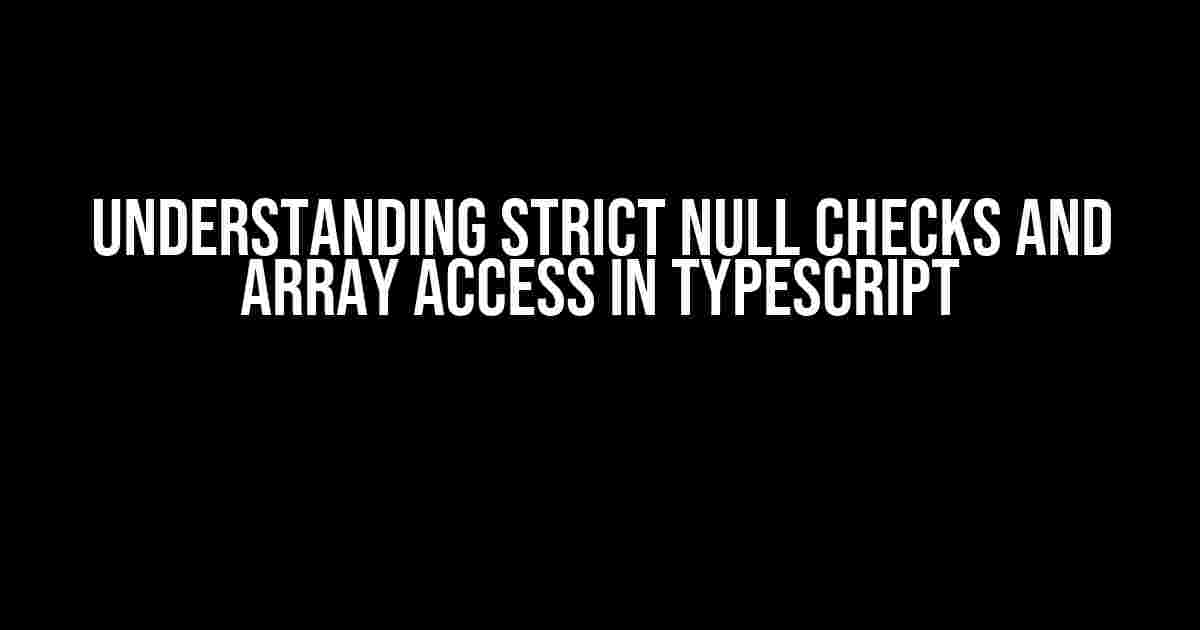TypeScript is a popular programming language that is widely used for building large-scale applications. It provides a robust type system that helps developers catch errors early and improve code maintainability. One of the key features of TypeScript is strict null checks, which helps prevent null and undefined references in code. However, when it comes to array access, strict null checks can sometimes lead to unexpected behavior. In this article, we will explore the concept of strict null checks and array access in TypeScript and how to handle them effectively.
What are Strict Null Checks?
Strict null checks are a feature in TypeScript that helps prevent null and undefined references in code. When enabled, it raises an error when a null or undefined value is accessed. This feature is enabled by default in TypeScript 2.0 and later versions. Strict null checks are useful because they help developers catch null pointer exceptions early, which can prevent runtime errors.
How do Strict Null Checks Work?
When strict null checks are enabled, TypeScript checks for null and undefined values at compile-time. If a null or undefined value is detected, it raises an error. This ensures that developers cannot accidentally access null or undefined values, which can lead to runtime errors.
Array Access and Strict Null Checks
Array access is a common operation in programming, where an element is retrieved from an array using its index. However, when strict null checks are enabled, array access can lead to unexpected behavior. Consider the following example:
let arr: string[] | null = ['hello', 'world']; let firstElement = arr[0]; // Error: Object is possibly 'null'.
In this example, the array `arr` is defined as a union type that can be either an array of strings or null. When we try to access the first element of the array, TypeScript raises an error because `arr` can be null. This is because strict null checks are enabled, and TypeScript is warning us that `arr` might be null.
Handling Array Access with Strict Null Checks
To handle array access with strict null checks, we need to ensure that the array is not null before accessing its elements. One way to do this is by using the optional chaining operator (`?.`) or the nullish coalescing operator (`??`). Consider the following examples:
let arr: string[] | null = ['hello', 'world']; let firstElement = arr?.[0]; // Returns 'hello' if arr is not null, otherwise returns undefined. let defaultElement = arr?.[0] ?? 'default'; // Returns 'hello' if arr is not null, otherwise returns 'default'.
In the first example, we use the optional chaining operator (`?.`) to access the first element of the array. If `arr` is null, the expression will return undefined. In the second example, we use the nullish coalescing operator (`??`) to provide a default value if `arr` is null.
Conclusion
In conclusion, strict null checks are an essential feature in TypeScript that helps prevent null and undefined references in code. However, when it comes to array access, strict null checks can sometimes lead to unexpected behavior. By using the optional chaining operator (`?.`) or the nullish coalescing operator (`??`), we can handle array access with strict null checks effectively and ensure that our code is robust and maintainable.
It’s worth noting that the concept of strict null checks and array access is not unique to TypeScript and applies to other programming languages as well. The key takeaway is to always ensure that arrays are not null before accessing their elements, and to use the optional chaining operator (`?.`) or the nullish coalescing operator (`??`) to provide a safe and default value.
- Enable strict null checks in your TypeScript configuration to catch null and undefined references early.
- Use the optional chaining operator (`?.`) or the nullish coalescing operator (`??`) to access array elements safely.
- Ensure that arrays are not null before accessing their elements.
Frequently Asked Question
Get ready to dive into the world of strictNullChecks and array access!
What does the strictNullChecks flag in TypeScript do?
The strictNullChecks flag is a compiler option in TypeScript that raises the bar on type safety by disallowing null and undefined from being assigned to variables, function parameters, and index signatures (like array access!). This flag helps catch common errors at compile-time, making your code more robust and reliable.
Why does array access throw an error with strictNullChecks?
When you access an array element, like arr[0], TypeScript can’t guarantee that the array isn’t null or undefined. With strictNullChecks enabled, TypeScript will error if it can’t prove that the array is not null or undefined, as it wants to prevent potential runtime errors. You can silence the error by using the non-null assertion operator (!) like arr![0], but be careful, as this can lead to runtime errors if the array actually is null or undefined!
How can I avoid null and undefined array accesses with strictNullChecks?
One way to avoid these errors is to use optional chaining (?.) or the nullish coalescing operator (??) to handle potential null or undefined values. For example, you can use arr?.[0] or arr?.[0] ?? ‘default value’ to provide a fallback in case the array is null or undefined.
Can I disable strictNullChecks for specific parts of my code?
Yes, you can use the // @ts-nocheck comment to disable type checking (including strictNullChecks) for a specific file or a block of code. However, be cautious when doing so, as it can lead to type safety issues. Alternatively, you can use the // @ts-ignore comment to ignore a specific error, but this should be avoided whenever possible.
Is it a good practice to enable strictNullChecks in my TypeScript project?
Absolutely! Enabling strictNullChecks can help you catch null and undefined-related errors at compile-time, making your code more reliable and maintainable. It might require some initial effort to fix existing issues, but it’s a valuable investment in the long run. So, go ahead and give your code a health check with strictNullChecks!
